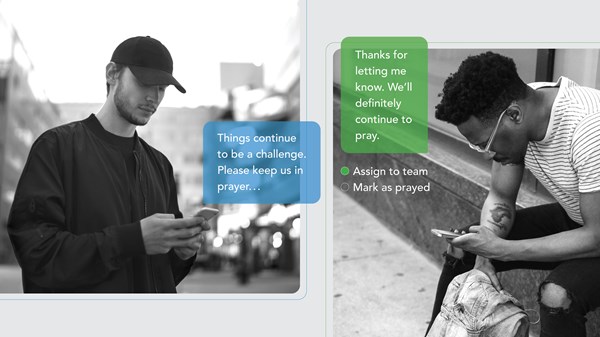It’s no wonder that pastors are exhausted. They spent 2020 facing questions like how can I reach people when we can’t gather together? and how can we minister with integrity and depth in a virtual context? Many church leaders also faced COVID-19 restrictions, racial tension, and political polarization.
Weary leaders entering the new year desire to be reunited with the heart of ministry—sharing the gospel and caring for their congregants. Distance and disruption have complicated pastor-congregant relationships, but they’ve also provided opportunities for new touchpoints to listen to congregants in innovative ways.
But what are these touchpoints telling us? What is it that people need?
Searching for support
Limited in their ability to talk to others about their feelings, concerns, or fears, millions have turned to the internet to find relief. Individuals and families who are trying to stay sane have sent terms like “online learning,” “activities for kids,” and “backyard ideas” rocketing up the Google Trends list.
“Although by no means a ‘window into the soul,’ people’s search terms reflect relatively uncensored desires for information and thus lack many of the biases of traditional self-report surveys,” one Google Trends study says.
More simply, people are searching for what they want to know. There’s no politeness or nuance to their words. Understanding those raw requests—whether “coffee delivery now” or “help with suicidal thoughts''—can help pastors understand what people in their communities are trying to discover. Pastors can then minister knowledgeably and with language that matches what their communities are using.
It’s not about changing the fundamental message, philosophy, or heartbeat of the church. It’s about speaking hope and help in a language that hurting people understand.
This year Google Trends lists “covid anxiety” and “coronavirus anxiety” as breakout trends, which means they have grown by more than 5000%. Other breakout topics? Searches for “loneliness,” “feeling,” and “friendship.” People are googling the term “vitamin D” in record numbers as they respond to months of being inside. “How to treat depression” and “crippling depression” are also breakout terms. So are “how much does a divorce cost” and “divorce lawyers near me.”
People are hurting and searching for answers as they spend yet another night at home, scrolling their phones, and hoping Netflix has something new. In “COVID-19 has anxious parents searching for inspiration, solutions, and comfort”, Google Ads Research and Insights Manager Daniel Trovato and Consumer Insights Manager Marina Helena Marinho write that “marketers have an opportunity to tailor their messaging and solutions to inspire, motivate, and comfort parents.” In “Therapist Digital Marketing Strategies During Covid-19,” Kennedy Kylander at Good Therapy encourages therapists to create relevant content for their websites. That content “might include therapist podcast show scheduling or blogs for clients that inform them of strategies to manage fear and anxiety during COVID-19 or the benefits of hiring a behavioral health provider”. And Liad Churchill writes in “New survey: What do customers expect from service providers during COVID-19?” at CustomerThink that “safety concerns are evolving as critical to brand loyalty. . . . With 55% of consumers admitting that they would terminate a relationship with a company if it failed to take proper safety precautions for both its employees and customers, the time has come for field service organizations to adapt to the new environment.”
Caring with clarity
What can pastors do with all of this information? Do they need to become digital marketers and SEO specialists to reach their communities in this virtual age? In a word, no. The answer isn’t technology expertise any more than it is adding cumbersome new programs. Instead, a needs-based approach helps pastors match what their churches already do—share the gospel and care for the community—with the needs of the people near them.
For example, pastor, if “divorce” or “support for couples” searches are trending in your area, perhaps it’s time to make sure your marriage ministry is well-described on your website, promoted on social media, and clearly described as accessible and safe for people with a range of COVID-19 risks and concerns. If parents are searching for activities for their kids, maybe your children’s ministry could host the occasional mid-week livestream for kids, offer guided family devotions, or provide a list with a few book or media suggestions for students of all age groups. If terms like “loneliness” and “anxiety” are surging around you, perhaps you could mobilize volunteers to serve as virtual coffee dates or book club hosts, which your website and social media channels can promote as community events.
If you’re ready to reach more people with the power of the gospel and support their everyday lives, a needs-based approach can help you do just that. But what does that look like in practical steps? Gloo, the creators of GlooConnect, put together a 2021 New Year Strategy Playbook with top tips on how churches can reach more people this year. Church leaders can go here to get their free copy of the bonus playbook.
You’ll never be able to meet every need, pastor, nor is that your calling. By setting your sights firmly on the gospel of Jesus and the call to make disciples, you can embrace the creativity and resources at your disposal. A needs-based approach isn’t a solution unto itself. It’s a tool—one that can help you build a safe harbor for your community members upon the firm foundation laid by Christ.


